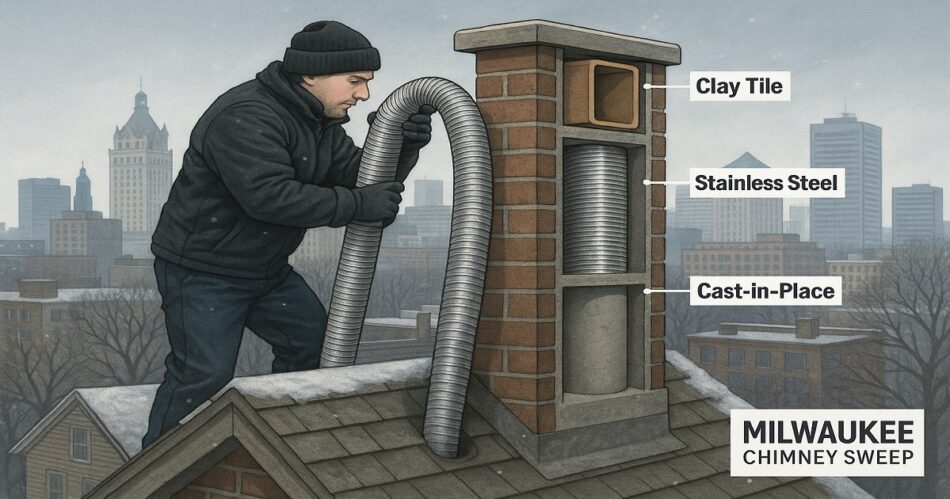Living in Milwaukee means getting used to some wild weather swings. One moment, it’s snowing sideways, and a few months later, you’re sweating through a muggy summer night. If you have a fireplace or wood stove, your chimney is right out there in all those extremes. A chimney liner might not be the first thing you think about when winter rolls around, but it’s a real MVP for keeping your home safe and your system working right. Let’s talk about which chimney liner materials can handle Milwaukee’s wild seasons, and why your choice matters more than you might realize.
“A solid chimney liner is like a winter coat for your chimney—without it, you’re left out in the cold.”
Key Features: What Makes a Liner Stand Up to Milwaukee’s Weather?
Not all chimney liners are the same, and some just aren’t built for the rollercoaster that is Milwaukee weather. When you’re picking a liner, you want something that can handle freezing wind in January, wild temperature changes in spring, and all the rain and humidity that comes with summer. Here are a few key things to look for:
- Durability against Freeze-Thaw Cycles: Milwaukee winters are tough, and water in your chimney can freeze and expand, cracking anything weak.
- Corrosion Resistance: Humidity, rain, and emissions from burning fuel can eat away at some materials over time.
- Flexibility: Chimneys aren’t always perfectly straight. Some liners need to bend and twist to fit older homes.
- Heat Tolerance: You want something that won’t break down after a few years of hot fires.
| Material | Durability | Weather Resistance | Flexibility | Maintenance |
|---|---|---|---|---|
| Stainless Steel | Excellent | Handles snow, rain, and ice | Flexible or Rigid options | Low |
| Clay Tile | Fair to Good | Cracks in freeze/thaw | Rigid only | Medium |
| Ceramic | Very Good | Resists heat and chemicals | Rigid only | Low |
| Aluminum | Poor | Not for woodburning or harsh weather | Flexible | Low |
Safety: Why the Right Chimney Liner Could Save Your Home
Milwaukee’s cold snaps can do a number on chimneys—water gets into cracks, then freezes and expands, making things worse every year. If your liner isn’t up to the job, you could be looking at a chimney fire or dangerous fumes sneaking into your living room. Stainless steel liners are a top pick here; they shrug off rust, resist heat, and can take a beating from the weather. Clay tiles, the old-school option, are common but tend to crack in our freeze-thaw cycles, which means they might not be the safest choice for the long haul.
Think of it this way: a good liner keeps smoke, carbon monoxide, and flames where they belong—inside the chimney and out of your house. That peace of mind is worth every penny.
Cost: What Will You Pay for Peace of Mind?
Let’s be real—nobody loves spending money on something they can’t even see. But skimping on a chimney liner can cost you way more if something goes wrong. Stainless steel liners are more expensive up front than clay, but they last much longer and usually come with great warranties. Aluminum liners are cheaper, but honestly, they just don’t cut it for Milwaukee’s weather and woodburning appliances.
Here’s a quick breakdown of what you might spend:
- Stainless Steel: Higher initial investment, but lasts 15–25 years (sometimes more).
- Clay Tile: Lower upfront cost, but may need repairs or replacement after harsh winters.
- Ceramic: Priced between clay and steel, with great longevity if installed correctly.
- Aluminum: Budget-friendly, but not recommended for tough climates like ours.
Spending a bit more up front could save you thousands on repairs—or worse, fire damage—down the road.
Emergency Service: When Things Go Wrong in the Dead of Winter
Picture this: it’s below zero, you’re trying to keep the house warm, and suddenly you smell smoke somewhere it shouldn’t be. Chimney problems in winter are the worst. That’s why having a tough, reliable liner matters—because you don’t want to be calling for emergency repairs when it’s ten below and snowing sideways. Stainless steel and ceramic liners rarely fail without warning, while clay can crack unexpectedly after a rough freeze. If you need help in a pinch, Milwaukee has some great local chimney pros who know what our winters can do and can fix things fast.
FAQs about Chimney Liner
Q: Can I install a chimney liner myself?
A: It’s possible if you’re handy, but chimneys are not the place to cut corners. Professional installation ensures safety and can help with warranties.
Q: How often should I check my chimney liner?
A: Once a year is a good rule, preferably before winter. If you notice weird smells, smoke, or bits of debris in your fireplace, check sooner.
Q: Do I have to replace my liner if I switch from wood to gas?
A: Maybe. Gas appliances need liners that handle moisture and lower temperatures. Always check with a professional before making changes.
Q: What signs mean my liner is failing?
A: Crumbling clay bits, rust flakes, odd drafts, or smoke backing up are all red flags. Don’t ignore them!
Final Thought:
Picking the right chimney liner for Milwaukee’s wild weather isn’t just about following codes—it’s about keeping your home safe, warm, and worry-free all year long. Stainless steel stands out for its durability and reliability, but whatever you choose, make sure it’s built to handle what our Midwest climate throws at it. When in doubt, talk to a local pro, and remember: a little extra care now can save you a whole lot of trouble later.
Read More: Milwaukee Chimney Sweep
 WhatsApp Us Now
WhatsApp Us Now







